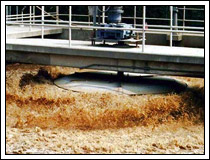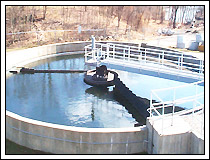Activated Sludge
Activated sludge is a suspended growth process, commonly employed to handle human waste and industrial waste in wastewater treatment plants. This process was invented by two British engineers, Edward Ardern and W.T. Lockett in an attempt to cope up with wastewater on a large scale in a hygienic and efficient way.

The term "Activated" implies that the particles contain a wide variety of bacteria and protozoa which can feed on the incoming wastewater. In this continuous or semi-continuous process, the carbonaceous organic matter in the wastewater supplies the energy for the breeding and production of new cells in a wide range of microorganisms. There also exist some other types of microbes that survive by oxidizing ammonia nitrogen to nitrate nitrogen through the process known as nitrification. Hence, it can be said that this process is based mainly on the aeration of wastewater with flocculating biological growth, followed by separation of treated wastewater from this growth.
Operation
A typical activated sludge plant consists of:
- Wastewater aeration in the presence of a microbial suspension
- Solid-liquid separation following aeration
- Discharge of clarified effluent
- Wasting of excess biomass, and
- Return of remaining biomass to the aeration tank.
The wastewater is aerated in an aeration basin which makes the micro-organisms metabolize the suspended and soluble organic matter. One part of the the organic matter is synthesized into new cells while the other is oxidized to CO2 and water to derive energy. The new cells so formed are removed to the settling tank in the form of flocculant sludge, a part of which is returned to the aeration tank and the remaining forms waste or excess sludge.
The activated sludge process is employed to achieve one of the following purposes:
- Oxidizing carbonaceous matter: biological matter
- Oxidizing nitrogenous matter: mainly ammonium and nitrogen in biological materials
- Removing phosphate
- Driving off entrained gases carbon dioxide, ammonia, nitrogen, etc
- Generating a biological floc that is easy to settle
- Generating a liquor that is low in dissolved or suspended material
Types of Activated Sludge Processes
A few key types of activated sludge processes include:
 Plug Flow: Where wastewater is routed through a series of channels constructed in the aeration basin. Plug Flow: Where wastewater is routed through a series of channels constructed in the aeration basin. - Complete Mix: In this process, the wastewater may be immediately mixed throughout the entire contents of the aeration basin (mixed with oxygen and bacteria).
- Contact Stabilization: Where the detention time is minimized, so the size of the contact tank can be smaller.
- Extended Aeration: Used to treat industrial wastewater containing soluble organics that need longer detention times.
- Oxidation Ditch: Oxidation ditch is similar to plug flow but uses a circulator aeration basin.
- Step Feed: Microbes gradually feed organics in a step feed mode at multiple points along the tank plug flow.
- Tapered Aeration: Air flow rate to the aeration basin may be tapered along the length of the basin.
- Kraus Process: The anaerobically digested sludge and digester supernatant may be added to the return sludge to improve settling of the floc.
|